Electrostatic Potential and Capacitance : Notes and Study Materials -pdf
- Concepts of Electrostatic Potential and Capacitance
- Electrostatic Potential and Capacitance Master File
- Ncert Solution
- NCERT Exemplar Solution
- Important Questions Electrostatic Potential And Capacitance
- Past Many Years CBSE Questions and Answer: Capacitor
- Past Many Years CBSE Questions and Answer: Electric Charges and Fields
- Test Paper 1
Class 12 Physics, Chapter 2 – Electrostatics Potential and Capacitance (based on NCERT books) are available in this article. These notes are helpful for revision purpose and important for CBSE Class 12 board examinations.
The notes of the chapter are as follow:
Electric Potential and Electric Potential Difference:
The amount of work done by an external force in moving a unit positive charge slowly (or without acceleration) from one point to another in an electrostatic field.
• When both the points are within the electrostatic field work done per unit positive charge is called potential difference.
• When the first point lies at infinity work done per the unit positive charge is called potential at the second point.
Mathematically, VY ‒ VX = WXY/qo
VY ‒ VX = WXY/qo
Where, VX , VY are potential at point X and Y respectively and WXY is the work done in moving test charge qo from point X to Y.
Electric Potential Due to a Point Charge:
Electric potential at a point in an electric field is defined as the amount of work done in moving a unit positive test charge from infinity to that point against the electrostatic forces, along any path.

Where, r is the magnitude of the position vector of the point and q is the source charge.
Electric Potential at a point due to ‘n’ number of Point Charges:
Electric potential due to a group of charges at a given point is the algebraic sum of the potentials due to individual charges
Electric Potential at a point due to an Electric dipole:
The electric potential at a point due to an electric dipole is given by the relation:
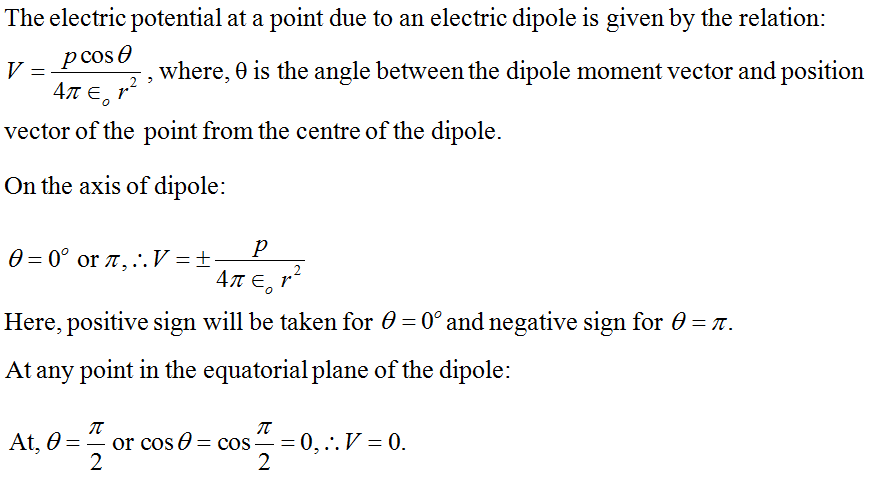
Equipotential Surfaces:
It is the surface at every point of which electric potential remain same.
There will be no work done in moving the test charge from one point of equipotential surface to the other.
Equipotential surface through a point is always normal to the electric field at that point.
Electrostatic Potential Energy due to a system of Charges:
It is the total amount of work done by an external agent in bringing them from infinity to the present arrangement in the system.
Electrostatic potential energy for a system of two charges q1 and q2 at a separation r is given by
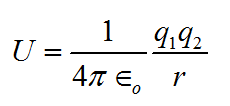
Electric Flux
It is defined as the total number of electric filed lines of force passing through the area normally.
Mathematically,

Gauss’s Theorem:
The electric flux through any closed surface is equal to 1/ εo times the total charge enclosed by the surface.
Mathematically,
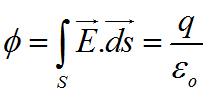
Where symbols have their respective meaning.
Electric Field Intensity Due to a Uniformly Charged Spherical Shell:
At any point outside the surface of the uniformly charged spherical shell –

Where, E is electric field, q is total charge on the sphere, r is the distance of the point from the centre of sphere.
At any point on the surface of the uniformly charged spherical shell –
The electric field on the surface of the uniformly charged spherical shell is maximum and given by,

At any point inside the uniformly charged spherical shell –
Inside the shell, charge (q) = 0, so, E = 0.
Electric Field Intensity Due to a Non-Conducting Charged Solid Sphere:
At any point inside the surface of the sphere –

Here, q is the total charge on the sphere, r is the radius of the Gaussian surface and R is the radius of the sphere.
At any point on the surface of the sphere –

At any point outside the surface of the sphere –

At the centre of the sphere –
E = 0
Electric Field Intensity Due to a Thin Infinite Plane Sheet of Charge

Electric Potential due to a Charged Conducting Sphere
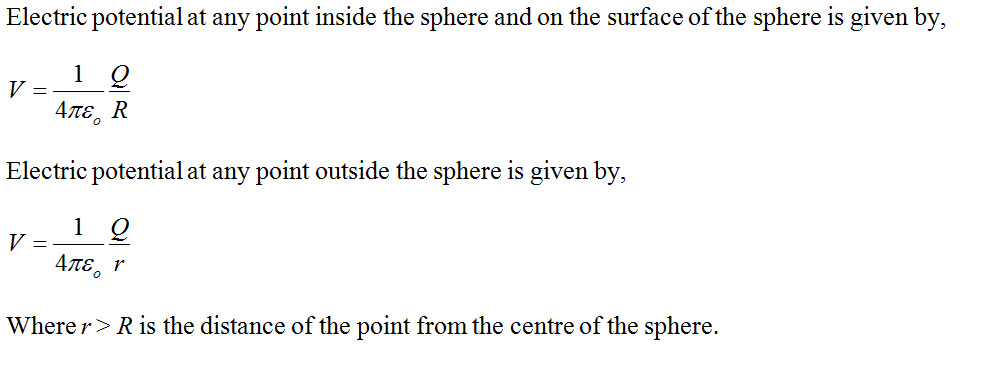
Dielectrics:
Dielectrics are non-conducting substances. In contrast to conductors, they have no (or negligible number of) charge carriers.
Types of dielectrics:
Dielectrics are of two types:
(i) Non-Polar Dielectrics: When the centre of positive charge coincides with the centre of negative charge in a molecule, e.g., Nitrogen, Oxygen, CO2 etc.
(ii) Polar Dielectrics: When the centre of positive and negative charges do not coincide because of the asymmetric shape of the molecules, e.g., NH3, HCl etc.
Dielectric Polarization:
In a dielectric, this free movement of charges is not possible. It turns out that the external field induces dipole moment by stretching or re-orienting molecules of the dielectric. The collective effect of all the molecular dipole moments is net charges on the surface of the dielectric which produce a field that opposes the external field. Unlike in a conductor, however, the opposing field so induced does not exactly cancel the external field. It only reduces it. The extent of the effect depends on the nature of the dielectric.

Image Source: NCERT Book
Capacitor:
It is an arrangement of primarily two conductors for storing large amount of electric charge.
Capacitance of a Capacitor:
Capacitance (C) of a capacitor is defined as ratio of charge (Q) given to the potential difference (V) applied across the conductors, i.e., C = Q/V.
The SI unit of capacitance is farad (F).
Capacitance of an Isolated Conducting Sphere:
The capacitance (C) of an isolated conducting sphere of radius (r) is given by C = 4 π ∈o r.
Parallel Plate Capacitor and Its Capacitance:
A parallel plate capacitor consists of two large plane parallel conducting plates separated by a small distance. The two plates have charges Q and –Q.
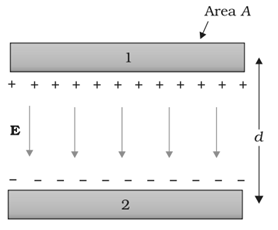
Image Source: NCERT Book
Parallel plate capacitor is an arrangement of two large metal plates of area A each kept parallel to each other at a distance d apart. If the space between the plates is vaccum (or air) then the capacitance of such an arrangement is given by,
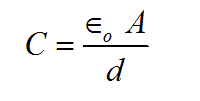
Combination of Capacitors
We can combine several capacitors of capacitance C1, C2,…, Cn to obtain a system with some effective capacitance C. The effective capacitance depends on the way the individual capacitors are combined. Two simple possible ways are:
Capacitors in Series:
In series arrangement the magnitude Q of charge on each plate is same
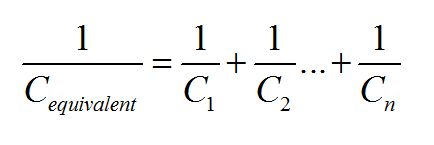
Capacitors in Parallel
In parallel arrangement the potential difference across the each capacitor will remain same.
CEquivalent = C1 + C2 + C3 . . . + Cn
Effect of Conductors in Capacitor
When a parallel plate capacitor is partially filled with a metallic slab of thickness t < d, its capacitance will be:
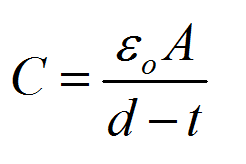
Effect of Dielectrics in Capacitor
When a dielectric slab of dielectric constant K having thickness t < d is placed between the plates of parallel plate capacitor.
The capacitance of the capacitor will be,

Energy Stored in Capacitor
Energy stored (U) in capacitor (C) charged to a potential difference V is given as,

Total Energy of the combination of capacitor:
Series combination:

Parallel combination:

Energy Density or Energy per Unit Volume:
The energy density or energy stored per unit volume of a charged capacitor is given by

Common Potential of charged capacitors
If C1and C2 are capacitors charged to potentials V1 and V2 respectively. These capacitors are connected by a conducting wire, charges flow from higher potential to lower potential. This flow of charge will continue till their potentials become equal. There will no charge is lost in sharing and their common potential is given by,
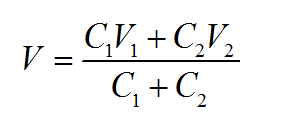
Energy dissipated when two charged capacitors are connected
If U1 is the total energy before sharing of charges and U2 is total energy after sharing of charges then,

CBSE Class 12 Physics Important Questions Chapter 2 – Electrostatic Potential and Capacitance
1 Mark Questions
1. Why does the electric field inside a dielectric decrease when it is placed in an external electric field?
Ans. The electric field, inside a dielectric decrease when it is placed is an external electric field due to polarisation as it creates an internal electric field opposite to external electric field inside a dielectric due to which net electric field gets reduced.
2. What is the work done in moving a 2  C point change from corner A to corner B of a square ABCD when a 10
C point change from corner A to corner B of a square ABCD when a 10  C charge exist at the center of the square?
C charge exist at the center of the square?
Ans. Since pt. A & B are at the same distance from the pt. O
VA = VB Work done = Zero.
Work done = Zero.
3. Force of attraction between two point electric charges placed at a distance d in a medium is F. What distance apart should these be kept in the same medium, so that force between them becomes F/3?
Ans. If two point changes are  separated by distance d
separated by distance d
F = 
Suppose if force becomes F/3 let the distance be x


 x =
x =  d
d
4. The distance of the field point on the equatorial plane of a small electric dipole is halved. By what factor will the electric filed due to the dipole change?
Ans. Since 

 Electric field becomes eight times
Electric field becomes eight times
5. The Plates of a charged capacitor are connected by a voltmeter. If the plates of the capacitor are moved further apart. What will be the effect on the reading of the voltmeter?
Ans. Since 
which means if distance increases, capacitance decreases.
Since  and charge on the capacitor is constant.
and charge on the capacitor is constant.
Hence reading of the voltmeter increases.
6. What happens to the capacitance of a capacitor when a dielectric slab is placed between its plates?
Ans.The introduction of dielectric in a capacitor reduces the effective charge on plate and hence increases the capacitance.
2 Marks Questions
1. Show mathematically that the potential at a point on the equatorial line of an electric dipole is Zero?
Ans. Electric potential at point P doe to the dipole
V = 
V=o
2. A parallel plate capacitor with air between the plates has a capacitance of  . What will be the capacitance if the distance between the plates is reduced by half and the space between them is filled with a substance of dielectric constant 6?
. What will be the capacitance if the distance between the plates is reduced by half and the space between them is filled with a substance of dielectric constant 6?
Ans. For air Co = 
Co =

Now d’ = d/2 and K = 6


3. Draw one equipotential surfaces (1) Due to uniform electric field (2) For a point charge (q < o)?
Ans.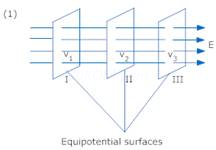
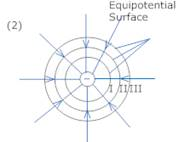
4. If the amount of electric flux entering and leaving a closed surface are  and
and  respectively. What is the electric charge inside the surface?
respectively. What is the electric charge inside the surface?
Ans. Net flux =  –
– 
Since 

 Q =
Q = 
5. A steam of electrons travelling with speed  at right angles to a uniform electric field E is deflected in a circular path of radius r. Prove that
at right angles to a uniform electric field E is deflected in a circular path of radius r. Prove that  ?
?
Ans. The path of the electron traveling with velocity  at right angles of
at right angles of  is circular.
is circular. It requires a centripetal force
It requires a centripetal force 
which is provided by an electrostatic force f = eE
 b
b
6. The distance between the plates of a parallel plate capacitor is d. A metal plate of thickness  is placed between the plates. What will be the effect on the capacitance?
is placed between the plates. What will be the effect on the capacitance?
Ans. For air 
Thickness t =  only when
only when 




 , Hence capacitance will get doubled.
, Hence capacitance will get doubled.
7. Two charges  are placed at points A and B 6 cm apart.
are placed at points A and B 6 cm apart.
1. Identify an equipotential surface of the system.
2. What is the direction of the electric field at every point on this surface?
Ans. The situation is represented in the given figure.
An equipotential surface is the plane on which total potential is zero everywhere. This plane is normal to line AB. The plane is located at the mid-point of line AB because the magnitude of charges is the same.
1. The direction of the electric field at every point on this surface is normal to the plane in the direction of AB.
8. In a Van de Graaff type generator a spherical metal shell is to be a  electrode. The dielectric strength of the gas surrounding the electrode is
electrode. The dielectric strength of the gas surrounding the electrode is  . What is the minimum radius of the spherical shell required? (You will learn from this exercise why one cannot build an electrostatic generator using a very small shell which requires a small charge to acquire a high potential.)
. What is the minimum radius of the spherical shell required? (You will learn from this exercise why one cannot build an electrostatic generator using a very small shell which requires a small charge to acquire a high potential.)
Ans. Potential difference, V = 
Dielectric strength of the surrounding gas = 
Electric field intensity, E = Dielectric strength = 
Minimum radius of the spherical shell required for the purpose is given by,

Hence, the minimum radius of the spherical shell required is 30 cm.
9. A small sphere of radius  and charge
and charge  is enclosed by a spherical shell of radius
is enclosed by a spherical shell of radius  and charge
and charge  . Show that if
. Show that if  is positive, charge will necessarily flow from the sphere to the shell (when the two are connected by a wire) no matter what the charge
is positive, charge will necessarily flow from the sphere to the shell (when the two are connected by a wire) no matter what the charge  on the shell is.
on the shell is.
Ans. According to Gauss’s law, the electric field between a sphere and a shell is determined by the charge  on a small sphere. Hence, the potential difference, V, between the sphere and the shell is independent of charge
on a small sphere. Hence, the potential difference, V, between the sphere and the shell is independent of charge  . For positive charge
. For positive charge  , potential difference V is always positive.
, potential difference V is always positive.
10. Describe schematically the equipotential surfaces corresponding to
1. a constant electric field in the z-direction,
2. a field that uniformly increases in magnitude but remains in a constant (say, z) direction,
3. a single positive charge at the origin, and
4. a uniform grid consisting of long equally spaced parallel charged wires in a plane.
Ans. 1. Equidistant planes parallel to the x-y plane are the equipotential surfaces.
2. Planes parallel to the x-y plane are the equipotential surfaces with the exception that when the planes get closer, the field increases.
3. Concentric spheres centered at the origin are equipotential surfaces.
4. A periodically varying shape near the given grid is the equipotential surface. This shape gradually reaches the shape of planes parallel to the grid at a larger distance.
3 Marks Questions
1.Two dielectric slabs of dielectric constant  are filled in between the two plates, each of area A, of the parallel plate capacitor as shown in the figure. Find the net capacitance of the capacitor? Area of each plate =
are filled in between the two plates, each of area A, of the parallel plate capacitor as shown in the figure. Find the net capacitance of the capacitor? Area of each plate = 

Ans. Here the two capacitors are in parallel Net capacitance
Net capacitance 




2. Prove that the energy stored in a parallel plate capacitor is given by  ?
?
Ans. Suppose a capacitor is connected to a battery and it supplies small amount of change dq at constant potential V, then small amount of work done by the battery is given by
dw = Vdq dw = qc/dq (Since q = CV)
dw = qc/dq (Since q = CV)
Total work done where capacitor is fully changed to q.



This work done is stored in the capacitor in the form of electrostatic potential energy.

3. State Gauss’s Theorem in electrostatics? Using this theorem define an expression for the field intensity due to an infinite plane sheet of change of charge density  ?
?
Ans. Gauss’s Theorem states that electric flux through a closed surface enclosing a charge q in vacuum is  times the magnitude of the charge enclosed
times the magnitude of the charge enclosed
Is 
Consider a charge is distributed over an infinite sheet of area S having surface change density  .
.
To enclose the charge on sheet an imaginary Gaussian surface cylindrical in shape is assumed and it is divided into three sections 
According to Gauss’s theorem
We know
For the given surface 
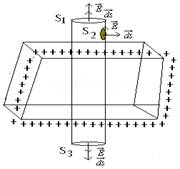





Combined eq. (1) & (2) 
E = 
E.2S = 
4. Derive an expression for the total work done in rotating an electric dipole through an angle  in a uniform electric field?
in a uniform electric field?
Ans. We know  = PE sin
= PE sin 
If an electric dipole is rotated through an angled  against the torque acting on it, then small amount of work done is
against the torque acting on it, then small amount of work done is
dw =  d
d = PE sin
= PE sin  d
d
For rotating through on angle  , from
, from 


w = – PE cos 
5. If  and
and  , calculate the equivalent capacitance of the given network between points A & B?
, calculate the equivalent capacitance of the given network between points A & B?

Ans. Since  are in series
are in series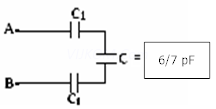




 and C are in series
and C are in series
Here  are in series
are in series


 Cnet = 60/61 pF
Cnet = 60/61 pF
6. Prove that energy stored per unit volume in a capacitor is given by  , where E is the electric field of the capacitor?
, where E is the electric field of the capacitor?
Ans. We know capacitance of a parallel plate capacitor,  , electric filed in between the plates
, electric filed in between the plates  where
where  is the surface charge density of the plates.
is the surface charge density of the plates.
Energy stored per unit volume = 
Energy stored per unit volume =  (Volume of the capacitor = Ad)
(Volume of the capacitor = Ad)
 Energy stored/volume =
Energy stored/volume = Hence proved
Hence proved
7. Keeping the voltage of the charging source constant. What would be the percentage change in the energy stored in a parallel plate capacitor if the separation between its plates were to be decreased by 10%?
Ans.
For parallel plate 
When d’ = d – 10% of d= 0.9 d
Then

Change in energy = U’-U = 

% change =

% change = 11.1%
8. Two identical plane metallic surfaces A and B are kept parallel to each other in air separated by a distance of 1.0 cm as shown in the figure. Surface A is given a positive potential of 10V and the outer surface of B is earthed.
(a) What is the magnitude and direction of uniform electric field between point Y and Z? What is the work done in moving a change of 20  from point X to Y?
from point X to Y?
(b) Can we have non-zero electric potential in the space, where electric field strength is zero?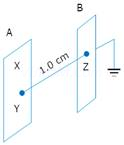
Ans. (a)Since 
(ii) Since surface A is an equipotential surface ie 
 Work done from X to Y = Zero .
Work done from X to Y = Zero .
(b) 
 Or V= constant (non zero)
Or V= constant (non zero)
So we can have non-zero electric potential, where electric field is zero.
9. A regular hexagon of side 10 cm has a charge 5  at each of its vertices. Calculate the potential at the centre of the hexagon.
at each of its vertices. Calculate the potential at the centre of the hexagon.
Ans. The given figure shows six equal amount of charges, q, at the vertices of a regular hexagon.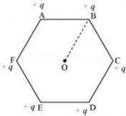
Where,
Charge, 
Side of the hexagon, l = AB = BC = CD = DE = EF = FA = 10 cm
Distance of each vertex from centre O, d = 10 cm
Electric potential at point O,
Where, = Permittivity of free space
= Permittivity of free space


Therefore, the potential at the centre of the hexagon is .
.
10. A spherical conductor of radius 12 cm has a charge of  distributed uniformly on its surface. What is the electric field
distributed uniformly on its surface. What is the electric field
1. Inside the sphere
2. Just outside the sphere
3. At a point 18 cm from the centre of the sphere?
Ans. Radius of the spherical conductor, r = 12 cm = 0.12 m
Charge is uniformly distributed over the conductor, 
Electric field inside a spherical conductor is zero. This is because if there is field inside the conductor, then charges will move to neutralize it.
1. Electric field E just outside the conductor is given by the relation,
Where, = Permittivity of free space
= Permittivity of free space


Therefore, the electric field just outside the sphere is  .
.
2. Electric field at a point 18 m from the centre of the sphere = 
Distance of the point from the centre, d = 18 cm = 0.18 m


Therefore, the electric field at a point 18 cm from the centre of the sphere is  .
.
11. Three capacitors each of capacitance 9 pF are connected in series.
1. What is the total capacitance of the combination?
2. What is the potential difference across each capacitor if the combination is connected to a 120 V supply?
Ans.Capacitance of each of the three capacitors, C = 9 pF
Equivalent capacitance  of the combination of the capacitors is given by the relation,
of the combination of the capacitors is given by the relation,


Therefore, total capacitance of the combination is  .
.
1. Supply voltage, V = 100 V
Potential difference  across each capacitor is equal to one-third of the supply voltage.
across each capacitor is equal to one-third of the supply voltage.
Therefore, the potential difference across each capacitor is 40 V.
12. Three capacitors of capacitances 2 pF, 3 pF and 4 pF are connected in parallel.
1. What is the total capacitance of the combination?
2. Determine the charge on each capacitor if the combination is connected to a 100 V supply.
Ans. Capacitances of the given capacitors are


For the parallel combination of the capacitors, equivalent capacitor is given by the algebraic sum,
is given by the algebraic sum,
Therefore, total capacitance of the combination is 9 pF.
1. Supply voltage, V = 100 V
The voltage through all the three capacitors is same = V = 100 V
Charge on a capacitor of capacitance C and potential difference V is given by the relation,
For C = 2 pF,

For C = 3 pF,

For C = 4 pF,

13. In a parallel plate capacitor with air between the plates, each plate has an area of  and the distance between the plates is 3 mm. Calculate the capacitance of the capacitor. If this capacitor is connected to a 100 V supply, what is the charge on each plate of the capacitor?
and the distance between the plates is 3 mm. Calculate the capacitance of the capacitor. If this capacitor is connected to a 100 V supply, what is the charge on each plate of the capacitor?
Ans. Area of each plate of the parallel plate capacitor, A 
Distance between the plates, d = 3 mm 
Supply voltage, V = 100 V
Capacitance C of a parallel plate capacitor is given by,
Where, = Permittivity of free space
= Permittivity of free space



Potential V is related with the charge q and capacitance C as



Therefore, capacitance of the capacitor is 17.71 pF and charge on each plate is  .
.
14. Explain what would happen if in the capacitor given in Exercise 2.8, a 3 mm thick mica sheet (of dielectric constant = 6) were inserted between the plates,
1. While the voltage supply remained connected.
2. After the supply was disconnected.
Ans.Dielectric constant of the mica sheet, k = 6
1. Initial capacitance, 
New capaci tan ce, 

Supply voltage, V = 100 V
New charge  s
s
Potential across the plates remains 100 V.
2. Dielectric constant, k = 6
Initial capacitance
New capacitance 
If supply voltage is removed, then there will be no effect on the amount of charge in the plates.
Charge = 
Potential across the plates is given by,


15. A 12 pF capacitor is connected to a 50V battery. How much electrostatic energy is stored in the capacitor?
Ans. Capacitor of the capacitance, 
Potential difference, V = 50 V
Electrostatic energy stored in the capacitor is given by the relation,














Therefore, the electrostatic energy stored in the capacitor is 
16. A 600 pF capacitor is charged by a 200 V supply. It is then disconnected from the supply and is connected to another uncharged 600 pF capacitor. How much electrostatic energy is lost in the process?
Ans. Capacitance of the capacitor, C = 600 pF Potential difference, V = 200 V
Electrostatic energy stored in the capacitor is given by,


If supply is disconnected from the capacitor and another capacitor of capacitance C = 600 pF is connected to it, then equivalent capacitance  of the combination is given by,
of the combination is given by,


New electrostatic energy can be calculated as


Loss in electrostatic energy =



Therefore, the electrostatic energy lost in the process is .
.
17. A spherical conducting shell of inner radius  and outer radius
and outer radius  has a charge
has a charge
1. A charge q is placed at the centre of the shell. What is the surface charge density on the inner and outer surfaces of the shell?
2. Is the electric field inside a cavity (with no charge) zero, even if the shell is not spherical, but has any irregular shape? Explain.
Ans. (a) Charge placed at the centre of a shell is +q. Hence, a charge of magnitude –q will be induced to the inner surface of the shell. Therefore, total charge on the inner surface of the shell is –q.
Surface charge density at the inner surface of the shell is given by the relation,

A charge of +q is induced on the outer surface of the shell. A charge of magnitude Q is placed on the outer surface of the shell. Therefore, total charge on the outer surface of the shell is Q + q. Surface charge density at the outer surface of the shell,
1. Yes
The electric field intensity inside a cavity is zero, even if the shell is not spherical and has any irregular shape. Take a closed loop such that a part of it is inside the cavity
along a field line while the rest is inside the conductor. Net work done by the field in carrying a test charge over a closed loop is zero because the field inside the conductor is zero. Hence, electric field is zero, whatever is the shape.
18. If one of the two electrons of a  molecule is removed, we get a hydrogen molecular ion
molecule is removed, we get a hydrogen molecular ion  . In the ground state of an
. In the ground state of an  , the two protons are separated by roughly 1.5
, the two protons are separated by roughly 1.5  , and the electron is roughly 1
, and the electron is roughly 1  from each proton. Determine the potential energy of the system. Specify your choice of the zero of potential energy.
from each proton. Determine the potential energy of the system. Specify your choice of the zero of potential energy.
Ans.
The system of two protons and one electron is represented in the given figure.
Charge on proton 1, 
Charge on proton 2, 
Charge on electron, 
Distance between protons 1 and 2, 
Distance between proton 1 and electron, 
Distance between proton 2 and electron, 
The potential energy at infinity is zero.
Potential energy of the system,
Substituting 



Therefore, the potential energy of the system is .
.
19. Two charged conducting spheres of radii a and b are connected to each other by a wire. What is the ratio of electric fields at the surfaces of the two spheres? Use the result obtained to explain why charge density on the sharp and pointed ends of a conductor is higher than on its flatter portions.
Ans.Let a be the radius of a sphere A, QA be the charge on the sphere, and CA be the capacitance of the sphere. Let b be the radius of a sphere B, QB be the charge on the sphere, and CB be the capacitance of the sphere. Since the two spheres are connected with a wire, their potential (V) will become equal.
Let EAbe the electric field of sphere A and EB be the electric field of sphere B. Therefore, their ratio,

However 
And 

Putting the value of (2) in (1), we obtain
Therefore, the ratio of electric fields at the surface is .
.
20. What is the area of the plates of a 2 F parallel plate capacitor, given that the separation between the plates is 0.5 cm? [You will realize from your answer why ordinary capacitors are in the range of  or less. However, electrolytic capacitors do have a much larger capacitance (0.1 F) because of very minute separation between the conductors.]
or less. However, electrolytic capacitors do have a much larger capacitance (0.1 F) because of very minute separation between the conductors.]
Ans.Capacitance of a parallel capacitor, V = 2 F
Distance between the two plates, d = 0.5 cm =  Capacitance of a parallel plate capacitor is given by the relation,
Capacitance of a parallel plate capacitor is given by the relation,
Where, = Permittivity of free space =
= Permittivity of free space = 

Hence, the area of the plates is too large. To avoid this situation, the capacitance is taken in the range of .
.
21.A spherical capacitor consists of two concentric spherical conductors, held in position by suitable insulating supports (Fig. 2.36).
Show that the capacitance of a spherical capacitor is given by where
where  and
and  are the radii of outer and inner spheres, respectively.
are the radii of outer and inner spheres, respectively.
Ans.Radius of the outer shell = 
Radius of the inner shell = 
The inner surface of the outer shell has charge +Q.
The outer surface of the inner shell has induced charge  Potential difference between the two shells is given by,
Potential difference between the two shells is given by,
Where, = Permittivity of free space
= Permittivity of free space

Capacitance of the given system is given by,
=
Hence, proved.
22. A cylindrical capacitor has two co-axial cylinders of length 15 cm and radii 1.5 cm and1.4 cm. The outer cylinder is earthed and the inner cylinder is given a charge of 3.5  . Determine the capacitance of the system and the potential of the inner cylinder. Neglect end effects (i.e., bending of field lines at the ends).
. Determine the capacitance of the system and the potential of the inner cylinder. Neglect end effects (i.e., bending of field lines at the ends).
Ans.Length of a co-axial cylinder, l = 15 cm = 0.15 m
Radius of outer cylinder,  = 1.5 cm = 0.015 m
= 1.5 cm = 0.015 m
Radius of inner cylinder,  = 1.4 cm = 0.014 m
= 1.4 cm = 0.014 m
Charge on the inner cylinder, q = 3.5 
Capacitance of a co-axil cylinder of radii  and
and is given by the relation,
is given by the relation,
Where, = Permittivity of free space =
= Permittivity of free space = 


Potential difference of the inner cylinder is given by,

23. A parallel plate capacitor is to be designed with a voltage rating 1 kV, using a material of dielectric constant 3 and dielectric strength about  . (Dielectric strength is the maximum electric field a material can tolerate without breakdown, i.e., without starting to conduct electricity through partial ionisation.) For safety, we should like the field never to exceed, say 10% of the dielectric strength. What minimum area of the plates is required to have a capacitance of 50 pF?
. (Dielectric strength is the maximum electric field a material can tolerate without breakdown, i.e., without starting to conduct electricity through partial ionisation.) For safety, we should like the field never to exceed, say 10% of the dielectric strength. What minimum area of the plates is required to have a capacitance of 50 pF?
Ans.Potential rating of a parallel plate capacitor, V = 1 kV = 1000 V
Dielectric constant of a material,  =3 Dielectric strength =
=3 Dielectric strength = 
For safety, the field intensity never exceeds 10% of the dielectric strength. Hence, electric field intensity, E = 10% of =
= 
Capacitance of the parallel plate capacitor, C = 50 pF =
Distance between the plates is given by,

Capacitance is given by the relation,
Where,
A = Area of each plate = Permittivity of free space =
= Permittivity of free space =


Hence, the area of each plate is about 19 .
.
5 Marks Questions
1. (a) Define dielectric constant in terms of the capacitance of a capacitor? On what factor does the capacitance of a parallel plate capacitor with dielectric depend?
(b) Find the ratio of the potential differences that must be applied across the
(1) parallel
(2) Series combination of two identical capacitors so that the energy stored in the two cases becomes the same.
Ans. (a) Dielectric constant is defined as the ratio of capacitance of a capacitor when the dielectric is filled in between the plates to the capacitance of a capacitor when there is vaccuum in between the plates
In K = 
Capacitance of a parallel plate capacitor with dielectric depends on the following factors 
(1) Area of the plates
(2) Distance between the plates
(3) Dielectric constant of the dielectric between the plates
(b) Let the capacitance of each capacitor be C
Cp = C + C = 2C (in parallel)
CS =  (in series)
(in series)
Let  be the values of potential difference
be the values of potential difference
This 



But  (given)
(given)

 Vp : Vs = 1 : 2
Vp : Vs = 1 : 2
2. (a) An air filled capacitor is given a charge of 2  C raising its potential to 200 V. If on inserting a dielectric medium, its potential falls to 50 V, what is the dielectric constant of the medium?
C raising its potential to 200 V. If on inserting a dielectric medium, its potential falls to 50 V, what is the dielectric constant of the medium?
(b) A conducting stab of thickness ‘t’ is introduced without touching between the
plates of a parallel plate capacitor separated by a distance d (t<d). Derive an
expression for the capacitance of a capacitor?
Ans. (a)  (Where V = 200 V for air filled capacitor
(Where V = 200 V for air filled capacitor  after insertion of a dielectric)
after insertion of a dielectric)
(b) For a parallel plate capacitor when air/vaccuum is in between the plates 
Since electric field inside a conducting stab is zero, hence electric field exist only between the space (d-t) 
Where  is the electric field exist between the plates?
is the electric field exist between the plates?
And 
Where A is the area of each plates
Hence capacitor of a parallel plate capacitor




3. Figure (a) and (b) shows the field lines of a single positive and negative changes respectively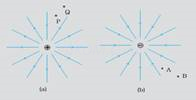
(a) Give the signs of the potential difference: 
(b) Give the sign of the work done by the field in moving a small positive change from Q to P.
(c) Give the sign of the work done by the field in moving a small negative change from B to A.
Ans. (a) We know 


Because is less negative then
is less negative then .
.
(b) In moving a positive change form Q to P work has to be done against the electric field so it is negative.
(c) In moving a negative change form B to A work is done along the same direction of the field so it is positive.
4. With the help of a labelled diagram, explain the principle, construction and working of a vandegraff generator. Mention its applications?
Ans. Vandegraff generator is a device which is capable of producing a high potential of the order of million volts.
Principle (1) The charge always resides on the outer surface of hollow conductor.
(2) The electric discharge in air or gas takes place readily at the pointed ends of the conductors.
Construction: – It consist of a large hollow metallic sphere S mounted on two insulating columns A and B and an endless belt made up of rubber which is running over two pulleys with the help of an electric motor.
with the help of an electric motor.  are two sharp metallic brushes. The lower brush
are two sharp metallic brushes. The lower brush  is given a positive potential by high tension battery and is called a spray brush while the upper brush
is given a positive potential by high tension battery and is called a spray brush while the upper brush  connected to the inner part of the Sphere S.
connected to the inner part of the Sphere S.
Working: – When brush  is given a high positive potential then it produces ions, due to the action of sharp points. Thus the positive ions so produced get sprayed on the belt due to repulsion between positive ions and the positive charge on brush
is given a high positive potential then it produces ions, due to the action of sharp points. Thus the positive ions so produced get sprayed on the belt due to repulsion between positive ions and the positive charge on brush . Then it is carried upward by the moving belt. The pointed end of
. Then it is carried upward by the moving belt. The pointed end of just touches the belt collects the positive change and make it move to the outer surface of the sphere S. This process continues and the potential of the shell rises to several million volts.
just touches the belt collects the positive change and make it move to the outer surface of the sphere S. This process continues and the potential of the shell rises to several million volts.
Applications – Particles like proton, Deutrons,  — particles etc are accelerated to high speeds and energies.
— particles etc are accelerated to high speeds and energies.
5. Two charges  and
and  are located 16 cm apart. At what point(s) on the line joining the two charges is the electric potential zero? Take the potential at infinity to be zero.
are located 16 cm apart. At what point(s) on the line joining the two charges is the electric potential zero? Take the potential at infinity to be zero.
Ans.There are two charges,

Distance between the two charges, d = 16 cm = 0.16 m
Consider a point P on the line joining the two charges, as shown in the given figure.
r = Distance of point P from charge
Let the electric potential (V) at point P be zero.
Potential at point P is the sum of potentials caused by charges q1 and q2 respectively.
Where, = Permittivity of free space
= Permittivity of free space
For V = 0, equation (i) reduces to




Therefore, the potential is zero at a distance of 10 cm from the positive charge between the charges.
Suppose point P is outside the system of two charges at a distance s from the negative charge, where potential is zero, as shown in the following figure.
For this arrangement, potential is given by,
For V = 0, equation (ii) reduces to





Therefore, the potential is zero at a distance of 40 cm from the positive charge outside the system of charges.
6. A parallel plate capacitor with air between the plates has a capacitance of 8 pF (  What will be the capacitance if the distance between the plates is reduced by half, and the space between them is filled with a substance of dielectric constant 6?
What will be the capacitance if the distance between the plates is reduced by half, and the space between them is filled with a substance of dielectric constant 6?
Ans. Capacitance between the parallel plates of the capacitor, C = 8 pF
Initially, distance between the parallel plates was d and it was filled with air. Dielectric constant of air, k = 1
Capacitance, C, is given by the formula,

Where,
A = Area of each plate = Permittivity of free space
= Permittivity of free space
If distance between the plates is reduced to half, then new distance,  Dielectric constant of the substance filled in between the plates,
Dielectric constant of the substance filled in between the plates,  = 6 Hence, capacitance of the capacitor becomes
= 6 Hence, capacitance of the capacitor becomes …….(ii)
…….(ii)
Taking ratios of equations (i) and (ii), we obtain


Therefore, the capacitance between the plates is 96 pF.
7. A charge of 8 mC is located at the origin. Calculate the work done in taking a small charge of  from a point P (0, 0, 3 cm) to a point Q (0, 4 cm, 0), via a point R
from a point P (0, 0, 3 cm) to a point Q (0, 4 cm, 0), via a point R
(0, 6 cm, 9 cm).
Ans. Charge located at the origin, q = 8 mC
Magnitude of a small charge, which is taken from a point P to point R to point Q, 
All the points are represented in the given figure.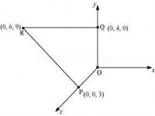
Point P is at a distance,  , from the origin along z-axis. Point Q is at a distance,
, from the origin along z-axis. Point Q is at a distance,  , from the origin along y-axis.
, from the origin along y-axis.
Potential at point P, 
Potential at point Q, 
Work done (W) by the electrostatic force is independent of the path.







Therefore, work done during the process is 1.27 J.
8. A cube of side b has a charge q at each of its vertices. Determine the potential and electric field due to this charge array at the centre of the cube.
Ans.Length of the side of a cube = b
Charge at each of its vertices = q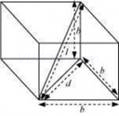
A cube of side b is shown in the following figure.
d = Diagonal of one of the six faces of the cube

l = Length of the diagonal of the cube




Is the difference between the centre of the cube and one of the eight vertices
The electric potential (V) at the centre of the cube is due to the presence of eight charges at the vertices.



Therefore, the potential at the centre of the cube is .
The electric field at the centre of the cube, due to the eight charges, gets cancelled. This is because the charges are distributed symmetrically with respect to the centre of the cube. Hence, the electric field is zero at the centre.
9. Two tiny spheres carrying charges 1.5  are located 30 cm apart. Find the potential and electric field:
are located 30 cm apart. Find the potential and electric field:
1. at the mid-point of the line joining the two charges, and
2. at a point 10 cm from this midpoint in a plane normal to the line and passing through the mid-point.
Ans.
Two charges placed at points A and B are represented in the given figure. O is the mid- point of the line joining the two charges.
Magnitude of charge located at A, q1 = 1.
Magnitude of charge located at B, q2 = 2.
Distance between the two charges, d = 30 cm = 0.3 m
1. Let are the electric potential and electric field respectively at O.
are the electric potential and electric field respectively at O.
V1 = Potential due to charge at A + Potential due to charge at B

Where, = Permittivity of free space
= Permittivity of free space


 = Electric field due to
= Electric field due to 



Therefore, the potential at mid-point is  and the electric field at mid-point is
and the electric field at mid-point is . The field is directed from the larger charge to the smaller charge.
. The field is directed from the larger charge to the smaller charge.
1. Consider a point Z such that normal distance OZ = 10 cm = 0.1 m, as shown in the following figure. are the electric potential and electric field respectively at Z. It can be observed from the figure that distance,
are the electric potential and electric field respectively at Z. It can be observed from the figure that distance,
BZ=AZ=
 = Electric potential due to A + Electric Potential due to B
= Electric potential due to A + Electric Potential due to B


Electric field due to q at Z,


Electric field due to q2 at Z,


The resultant field intensity at Z,
Where,  is the angle,
is the angle, 
From the figure, we obtain





Therefore, the potential at a point 10 cm (perpendicular to the mid-point) is  and electric field is
and electric field is .
.
10. Show that the normal component of electrostatic field has a discontinuity from one side of a charged surface to another given by  Where
Where  is a unit vector normal to the surface at a point and σ is the surface charge density at that point. (The direction of
is a unit vector normal to the surface at a point and σ is the surface charge density at that point. (The direction of  is from side 1 to side 2.) Hence show that just outside a conductor, the electric field is
is from side 1 to side 2.) Hence show that just outside a conductor, the electric field is 
1. Show that the tangential component of electrostatic field is continuous from one side of a charged surface to another. [Hint: For (a), use Gauss’s law. For, (b) use the fact that work done by electrostatic field on a closed loop is zero.]
Ans. Electric field on one side of a charged body is and electric field on the other side of the same body is
and electric field on the other side of the same body is . If infinite plane charged body has a uniform thickness, then electric field due to one surface of the charged body is given by,
. If infinite plane charged body has a uniform thickness, then electric field due to one surface of the charged body is given by,
Where, = Unit vector normal to the surface at a point σ = Surface charge density at that point Electric field due to the other surface of the charged body,
= Unit vector normal to the surface at a point σ = Surface charge density at that point Electric field due to the other surface of the charged body,
Electric field at any point due to the two surfaces,


Since inside a closed conductor,  = 0,
= 0,

Therefore, the electric field just outside the conductor is.
1. When a charged particle is moved from one point to the other on a closed loop, the work done by the electrostatic field is zero. Hence, the tangential component of electrostatic field is continuous from one side of a charged surface to the other.
11. A long charged cylinder of linear charged density  is surrounded by a hollow co-axial conducting cylinder. What is the electric field in the space between the two cylinders?
is surrounded by a hollow co-axial conducting cylinder. What is the electric field in the space between the two cylinders?
Ans. Charge density of the long charged cylinder of length L and radius r is λ.
Another cylinder of same length surrounds the pervious cylinder. The radius of this cylinder is R.
Let E be the electric field produced in the space between the two cylinders.
Electric flux through the Gaussian surface is given by Gauss’s theorem as,
Where, d = Distance of a point from the common axis of the cylinders Let q be the total charge on the cylinder.
It can be written as
Where,
q = Charge on the inner sphere of the outer cylinder = Permittivity of free space
= Permittivity of free space


Therefore, the electric field in the space between the two cylinders is .
12.In a hydrogen atom, the electron and proton are bound at a distance of about 0.53  .
.
1. Estimate the potential energy of the system in eV, taking the zero of the potential energy at infinite separation of the electron from proton.
2. What is the minimum work required to free the electron, given that its kinetic energy in the orbit is half the magnitude of potential energy obtained in (a)?
3. What are the answers to (a) and (b) above if the zero of potential energy is taken at 1.06  separation?
separation?
Ans.The distance between electron-proton of a hydrogen atom, 
Charge on an electron, 
Charge on a proton, 
1. Potential at infinity is zero.
Potential energy of the system, p-e = Potential energy at infinity -Potential energy at distance, d
Where, is the permittivity of free space
is the permittivity of free space

 Potential enerygy
Potential enerygy
Since 

 Potential energy
Potential energy

Therefore, the potential energy of the system is 
2. Kinetic energy is half of the magnitude of potential energy.
Kinetic energy
Total energy =  = 13.6 eV
= 13.6 eV
Therefore, the minimum work required to free the electron is 13.6 eV.
3. When zero of potential energy is taken, 
 Potential energy of the system = Potential energy at
Potential energy of the system = Potential energy at  – Potential energy at d
– Potential energy at d




13. Two charges  are located at points
are located at points  respectively.
respectively.
1. What is the electrostatic potential at the points?
2. Obtain the dependence of potential on the distance r of a point from the origin when r/a >> 1.
3. How much work is done in moving a small test charge from the point (5, 0, 0) to  along the x-axis? Does the answer change if the path of the test charge between the same points is not along the x-axis?
along the x-axis? Does the answer change if the path of the test charge between the same points is not along the x-axis?
Ans.  Zero at both the points
Zero at both the points
Charge  and charge + q is located at (0, 0, a). Hence, they form a dipole. Point (0, 0, z) is on the axis of this dipole and point (x, y, 0) is normal to the axis of the dipole. Hence, electrostatic potential at point (x, y, 0) is zero. Electrostatic potential at point (0, 0, z) is given by,
and charge + q is located at (0, 0, a). Hence, they form a dipole. Point (0, 0, z) is on the axis of this dipole and point (x, y, 0) is normal to the axis of the dipole. Hence, electrostatic potential at point (x, y, 0) is zero. Electrostatic potential at point (0, 0, z) is given by,



Where, = Permittivity of free space
= Permittivity of free space
p = Dipole moment of the system of two charges = 2qa
2. Distance r is much greater than half of the distance between the two charges. Hence, the potential (V) at a distance r is inversely proportional to square of the distance
i.e., 
3. Zero
The answer does not change if the path of the test is not along the x-axis.
A test charge is moved from point (5, 0, 0) to point (-7, 0, 0) along the x-axis. Electrostatic potential  at point (5, 0, 0) is given by,
at point (5, 0, 0) is given by,



Electrostatic potential,  , at point (- 7, 0, 0) is given by,
, at point (- 7, 0, 0) is given by,



Hence, no work is done in moving a small test charge from point (5, 0, 0) to point (−7, 0, 0) along the x-axis.
The answer does not change because work done by the electrostatic field in moving a test charge between the two points is independent of the path connecting the two points.
14. Figure 2.34 shows a charge array known as an electric quadrupole. For a point on the axis of the quadrupole, obtain the dependence of potential on r for r/a >> 1, and contrast your results with that due to an electric dipole, and an electric monopole (i.e., a single charge).
Ans. Four charges of same magnitude are placed at points X, Y, Y, and Z respectively, as shown in the following figure.
A point is located at P, which is r distance away from point Y. The system of charges forms an electric quadrupole.
It can be considered that the system of the electric quadrupole has three charges.
Charge +q placed at point X
Charge  placed at point Y
placed at point Y
Charge +q placed at point Z
XY = YZ = a
YP = r
PX = r + a
PZ = 
Electrostatic potential caused by the system of three charges at point P is given by,






Since ,
,
 is taken as negligible.
is taken as negligible.
It can be inferred that potential, 
However, it is known that for a dipole, 
And, for a monopole,
15. An electrical technician requires a capacitance of  in a circuit across a potential difference of 1 kV. A large number of 1 2µF capacitors are available to him each of which can withstand a potential difference of not more than 400 V. Suggest a possible arrangement that requires the minimum number of capacitors.
in a circuit across a potential difference of 1 kV. A large number of 1 2µF capacitors are available to him each of which can withstand a potential difference of not more than 400 V. Suggest a possible arrangement that requires the minimum number of capacitors.
Ans. Total required capacitance, C =  Potential difference, V = 1 kV = 1000 V Capacitance of each capacitor,
Potential difference, V = 1 kV = 1000 V Capacitance of each capacitor,  =
= 
Each capacitor can withstand a potential difference,  = 400 V
= 400 V
Suppose a number of capacitors are connected in series and these series circuits are connected in parallel (row) to each other. The potential difference across each row must be 1000 V and potential difference across each capacitor must be 400 V. Hence, number of capacitors in each row is given as
Hence, there are three capacitors in each row. Capacitance of each row 
 +…….n terms
+…….n terms
However, capacitance of the ciruit is given as 2 .
.
N=6
Let there are n rows, each having three capacitors, which are connected in parallel. Hence, equivalent capacitance of the circuit is given as
Hence, 6 rows of three capacitors are present in the circuit. A minimum of  i.e., 18 capacitors are required for the given arrangement.
i.e., 18 capacitors are required for the given arrangement.
16.Obtain the equivalent capacitance of the network in Fig. 2.35. For a 300 V supply, determine the charge and voltage across each capacitor.
Ans.Capacitance of capacitor  is 100 pF.
is 100 pF.
Capacitance of capacitor  is 200 pF.
is 200 pF.
Capacitance of capacitor  is 200 pF.
is 200 pF.
Capacitance of capacitor  is 100 pF.
is 100 pF.
Supply potential, V = 300 V
Capacitors  and
and  are connected in series. Let their equivalent capacitance be
are connected in series. Let their equivalent capacitance be 

 =100pF
=100pF
Capacitors  are in parallel. Let their equivalent capacitance be
are in parallel. Let their equivalent capacitance be 

=100+100=200pF are connected in series. Let their equivalent capacitance be C.
are connected in series. Let their equivalent capacitance be C.


Hence, the equivalent capacitance of the circuit is  Potential difference across
Potential difference across 
Potential difference across  =
= 

Charge on  is given by,
is given by, = CV
= CV



 voltage across
voltage across is given by,
is given by,
=300-200=100V


Hence, potential difference,  , across
, across is 100 V. Charge on
is 100 V. Charge on  is given by,
is given by, and
and  having same capacitances have a potential difference of 100 V together. Since
having same capacitances have a potential difference of 100 V together. Since and
and  are in series, the potential difference across
are in series, the potential difference across  and
and  is given by,
is given by, =
=  = 50 V
= 50 V
Therefore, charge on  is given by,
is given by,


And charge on  is given by,
is given by,


 pF with
pF with
Hence, the equivalent capacitance of the given circuit is







17. The plates of a parallel plate capacitor have an area of 90  each and are separated by 2.5 mm. The capacitor is charged by connecting it to a 400 V supply.
each and are separated by 2.5 mm. The capacitor is charged by connecting it to a 400 V supply.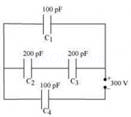
1. How much electrostatic energy is stored by the capacitor?
2. View this energy as stored in the electrostatic field between the plates, and obtain the energy per unit volume u. Hence arrive at a relation between u and the magnitude of electric field E between the plates.
Ans. Area of the plates of a parallel plate capacitor, A = 90  =
= 
Distance between the plates, d = 2.5 mm = 
Potential difference across the plates, V = 400 V
1. Capacitance of the capacitor is given by the relation,
Electrostatic energy stored in the capacitor is given by the relation, 

Where, = Permittivity of free space =
= Permittivity of free space = 



Hence, the electrostatic energy stored by the capacitor is 
2. Volume of the given capacitor,


Energy stored in the capacitor per unit volume is given by,

Again, u=
Where, = Electric intensity = E
= Electric intensity = E
18. A 4  capacitor is charged by a 200 V supply. It is then disconnected from the supply, and is connected to another uncharged 2
capacitor is charged by a 200 V supply. It is then disconnected from the supply, and is connected to another uncharged 2  capacitor. How much electrostatic energy of the first capacitor is lost in the form of heat and electromagnetic radiation?
capacitor. How much electrostatic energy of the first capacitor is lost in the form of heat and electromagnetic radiation?
Ans. Capacitance of a charged capacitor,  Supply voltage,
Supply voltage,  = 200 V Electrostatic energy stored in
= 200 V Electrostatic energy stored in  is given by,
is given by,



 F
F
Capacitance of an uncharged capacitor,
When  is connected to the circuit, the potential acquired by it is
is connected to the circuit, the potential acquired by it is  .
.



According to the conservation of charge, initial charge on capacitor  is equal to the final charge on capacitors,
is equal to the final charge on capacitors,  and
and  .
.
Electrostatic energy for the combination of two capacitors is given by,


Hence, amount of electrostatic energy lost by capacitor 
19. Show that the force on each plate of a parallel plate capacitor has a magnitude equal to  QE, where Q is the charge on the capacitor, and E is the magnitude of electric field between the plates. Explain the origin of the factor
QE, where Q is the charge on the capacitor, and E is the magnitude of electric field between the plates. Explain the origin of the factor  .
.
Ans. Let F be the force applied to separate the plates of a parallel plate capacitor by a distance of . Hence, work done by the force to do so
. Hence, work done by the force to do so 
As a result, the potential energy of the capacitor increases by an amount given as .
.
Where,
u = Energy density
A = Area of each plate
d = Distance between the plates
V = Potential difference across the plates
The work done will be equal to the increase in the potential energy i.e.,

Electric intensity is given by,

However, capacitance, 

Charge on the capacitor is given by,
Q = CV
The physical origin of the factor,  , in the force formula lies in the fact that just outside the conductor, field is E and inside it is zero. Hence, it is the average value,
, in the force formula lies in the fact that just outside the conductor, field is E and inside it is zero. Hence, it is the average value,  , of the field that contributes to the force.
, of the field that contributes to the force.
20. A spherical capacitor has an inner sphere of radius 12 cm and an outer sphere of radius 13 cm. The outer sphere is earthed and the inner sphere is given a charge of 2.5 µC. The space between the concentric spheres is filled with a liquid of dielectric constant 32.
1. Determine the capacitance of the capacitor.
2. What is the potential of the inner sphere?
3. Compare the capacitance of this capacitor with that of an isolated sphere of radius 12 cm. Explain why the latter is much smaller.
Ans. Radius of the inner sphere,  = 12 cm = 0.12 m Radius of the outer sphere,
= 12 cm = 0.12 m Radius of the outer sphere,  = 13 cm = 0.13 m Charge on the inner sphere,
= 13 cm = 0.13 m Charge on the inner sphere,
Dielectric constant of a liquid, 
(a) Capacitance of the capacitor is given by the relatioon,
Where, = Permittivity of free space =
= Permittivity of free space = 



Hence, the capacitance of the capacitor is approximately.
1. Potential of the inner sphere is given by,

Hence, the potential of the inner sphere is  .
.
2. Radius of an isolated sphere, r = 
3. Capacitance of the sphere is given by the relation,


The capacitance of the isolated sphere is less in comparison to the concentric spheres. This is because the outer sphere of the concentric spheres is earthed. Hence, the potential difference is less and the capacitance is more than the isolated sphere.
21. Answer carefully:
1. Two large conducting spheres carrying charges  and
and  are brought close to each other. Is the magnitude of electrostatic force between them exactly given by
are brought close to each other. Is the magnitude of electrostatic force between them exactly given by 
 , where r is the distance between their centres?
, where r is the distance between their centres?
2. If Columb’s law involved  dependence (instead of
dependence (instead of  ), would Gauss’s law be still true?
), would Gauss’s law be still true?
3. A small test charge is released at rest at a point in an electrostatic field configuration. Will it travel along the field line passing through that point?
4. What is the work done by the field of a nucleus in a complete circular orbit of the electron? What if the orbit is elliptical?
1. We know that electric field is discontinuous across the surface of a charged conductor. Is electric potential also discontinuous there?
2. What meaning would you give to the capacitance of a single conductor?
3. Guess a possible reason why water has a much greater dielectric constant (= 80) than say, mica (= 6).
Ans. 1. The force between two conducting spheres is not exactly given by the expression , because there is a non-uniform charge distribution on the spheres.
, because there is a non-uniform charge distribution on the spheres.
2. Gauss’s law will not be true, if Coulomb’s law involved  dependence, instead of
dependence, instead of  , on r.
, on r.
3. Yes, If a small test charge is released at rest at a point in an electrostatic field configuration, then it will travel along the field lines passing through the point, only if the field lines are straight. This is because the field lines give the direction of acceleration and not of velocity.
1. Whenever the electron completes an orbit, either circular or elliptical, the work done by the field of a nucleus is zero.
2. No Electric field is discontinuous across the surface of a charged conductor. However, electric potential is continuous.
1. The capacitance of a single conductor is considered as a parallel plate capacitor with one of its two plates at infinity.
2. Water has an unsymmetrical space as compared to mica. Since it has a permanent dipole moment, it has a greater dielectric constant than mica.
22. Answer the following:
1. The top of the atmosphere is at about 400 kV with respect to the surface of the earth, corresponding to an electric field that decreases with altitude. Near the surface of the earth, the field is about 100  . Why then do we not get an electric shock as we step out of our house into the open? (Assume the house to be a steel cage so there is no field inside!)
. Why then do we not get an electric shock as we step out of our house into the open? (Assume the house to be a steel cage so there is no field inside!)
2. A man fixes outside his house one evening a two metre high insulating slab carrying on its top a large aluminium sheet of area  . Will he get an electric shock if he touches the metal sheet next morning?
. Will he get an electric shock if he touches the metal sheet next morning?
3. The discharging current in the atmosphere due to the small conductivity of air is known to be 1800 A on an average over the globe. Why then does the atmosphere not discharge itself completely in due course and become electrically neutral? In other words, what keeps the atmosphere charged?
4. What are the forms of energy into which the electrical energy of the atmosphere is dissipated during a lightning? (Hint: The earth has an electric field of about  at its surface in the downward direction, corresponding to a surface charge density =
at its surface in the downward direction, corresponding to a surface charge density = 
 . Due to the slight conductivity of the atmosphere up to about 50 km (beyond which it is good conductor), about + 1800 C is pumped every second into the earth as a
. Due to the slight conductivity of the atmosphere up to about 50 km (beyond which it is good conductor), about + 1800 C is pumped every second into the earth as a
whole. The earth, however, does not get discharged since thunderstorms and lightning occurring continually all over the globe pump an equal amount of negative charge on the earth.)
Ans. We do not get an electric shock as we step out of our house because the original equipotential surfaces of open air changes, keeping our body and the ground at the same potential.
1. Yes, the man will get an electric shock if he touches the metal slab next morning. The steady discharging current in the atmosphere charges up the aluminum sheet. As a result, its voltage rises gradually. The raise in the voltage depends on the capacitance of the capacitor formed by the aluminium slab and the ground.
2. The occurrence of thunderstorms and lightning charges the atmosphere continuously. Hence, even with the presence of discharging current of 1800 A, the atmosphere is not discharged completely. The two opposing currents are in equilibrium and the atmosphere remains electrically neutral.
3. During lightning and thunderstorm, light energy, heat energy, and sound energy are dissipated in the atmosphere.